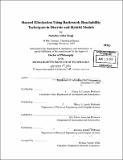| dc.contributor.advisor | Nancy G. Leveson. | en_US |
| dc.contributor.author | Neogi, Natasha A. (Natasha Anita), 1976- | en_US |
| dc.contributor.other | Massachusetts Institute of Technology. Dept. of Aeronautics and Astronautics. | en_US |
| dc.date.accessioned | 2005-08-24T20:19:12Z | |
| dc.date.available | 2005-08-24T20:19:12Z | |
| dc.date.copyright | 2001 | en_US |
| dc.date.issued | 2002 | en_US |
| dc.identifier.uri | http://hdl.handle.net/1721.1/8099 | |
| dc.description | Thesis (Ph. D.)--Massachusetts Institute of Technology, Dept. of Aeronautics and Astronautics, February 2002. | en_US |
| dc.description | Includes bibliographical references (leaves 173-181). | en_US |
| dc.description.abstract | One of the most important steps in hazard analysis is determining whether a particular design can reach a hazardous state and, if it could, how to change the design to ensure that it does not. In most cases, this is done through testing or simulation or even less rigorous processes--none of which provide much confidence for complex systems. Because state spaces for software can be enormous (which is why testing is not an effective way to accomplish the goal), the innovative Hazard Automaton Reduction Algorithm (HARA) involves starting at a hypothetical unsafe state and using backwards reachability techniques to obtain enough information to determine how to design in order to ensure that state cannot be reached. State machine models are very powerful, but also present greater challenges in terms of reachability, including the backwards reachability needed to implement the Hazard Automaton Reduction Algorithm. The key to solving the backwards reachability problem lies in converting the state machine model into a controls state space formulation and creating a state transition matrix. Each successive step backward from the hazardous state then involves only one n by n matrix manipulation. Therefore, only a finite number of matrix manipulations is necessary to determine whether or not a state is reachable from another state, thus providing the same information that could be obtained from a complete backwards reachability graph of the state machine model. Unlike model checking, the computational cost does not increase as greatly with the number of backward states that need to be visited to obtain the information necessary to ensure that the design is safe or to redesign it to be safe. The functionality and optimality of this approach is proved in both discrete and hybrid cases. | en_US |
| dc.description.abstract | (cont.) The new approach of the Hazard Automaton Reduction Algorithm combined with backwards reachability controls techniques was demonstrated on a blackbox model of a real aircraft altitude switch. The algorithm is being implemented in a commercial specification language (SpecTRM-RL). SpecTRM-RL is formally extended to include continuous and hybrid models. An analysis of the safety of a medium term conflict detection algorithm (MTCD) for aircraft, that is being developed and tested by Eurocontrol for use in European Air Traffic Control, is performed. Attempts to validate such conflict detection algorithms is currently challenging researchers world wide. Model checking is unsatisfactory in general for this problem because of the lack of a termination guarantee in backwards reachability using model checking. The new state-space controls approach does not encounter this problem. | en_US |
| dc.description.statementofresponsibility | by Natasha Anita Neogi. | en_US |
| dc.format.extent | 206 leaves | en_US |
| dc.format.extent | 14891011 bytes | |
| dc.format.extent | 14890770 bytes | |
| dc.format.mimetype | application/pdf | |
| dc.format.mimetype | application/pdf | |
| dc.language.iso | eng | en_US |
| dc.publisher | Massachusetts Institute of Technology | en_US |
| dc.rights | M.I.T. theses are protected by copyright. They may be viewed from this source for any purpose, but reproduction or distribution in any format is prohibited without written permission. See provided URL for inquiries about permission. | en_US |
| dc.rights.uri | http://dspace.mit.edu/handle/1721.1/7582 | |
| dc.subject | Aeronautics and Astronautics. | en_US |
| dc.title | Hazard elimination using backwards reachability techniques in discrete and hybrid models | en_US |
| dc.type | Thesis | en_US |
| dc.description.degree | Ph.D. | en_US |
| dc.contributor.department | Massachusetts Institute of Technology. Department of Aeronautics and Astronautics | |
| dc.identifier.oclc | 51279017 | en_US |
